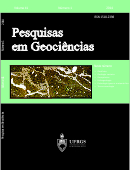Apatite fission track thermochronology applied to igneous basement and sedimentary rocks from Amazonas Basin, in Itaituba region PA, Brazil
DOI:
https://doi.org/10.22456/1807-9806.78033Keywords:
thermochronology, fission tracks, magmatism, uplift, exhumation, Amazonas Basin.Abstract
The apatite fission track thermochronology was used to investigate the thermotectonic evolution of the Amazonas Basin in the region of Itaituba (PA). The apatite fission track (AFT) data are mainly from the Paleoproterozoic igneous rocks of the basement (~1.88 Ga), as well as a sample of the sandstone sequence Pennsylvanian-Permian. The fission track ages and mathematical modeling data of the basement samples suggested two cooling/uplift events and a heating event between them. The older cooling/uplift event, starting between 306 and 280 Ma, may be associated with the Pangea amalgamation (320-270 Ma) and with the deglaciation of Gondwana (~300 Ma). The second cooling/uplift event, which started between 117 and 98 Ma may be related to the deformation (anticlines and inverse faults) in the rocks of the Amazonas Basin that occurred during the Upper Cretaceous. The heating event that occurred in between is associated with the widespread mafic magmatism related to break up of Pangea (~200 Ma) and formation of the Central Atlantic Ocean, known as Penatecaua magmatism in the Amazonas Basin. The ATF data for the sedimentary rock of the basin recorded the Upper Cretaceous uplift event and suggested a higher rate of exhumation in the beginning of the Paleogene.Downloads
Download data is not yet available.
Downloads
Published
2014-04-27
How to Cite
PINA, A. C. M., MOURA, C. A. V., & VIGNOL-LELARGE, M. L. (2014). Apatite fission track thermochronology applied to igneous basement and sedimentary rocks from Amazonas Basin, in Itaituba region PA, Brazil. Pesquisas Em Geociências, 41(1), 39–50. https://doi.org/10.22456/1807-9806.78033
Issue
Section
Articles



